Two Wires With Currents as Indicated Are Shown Below. Where Is the B-field Zero?
Sources of Magnetic Fields
79 Magnetic Force between Two Parallel Currents
Learning Objectives
By the end of this section, you will be able to:
- Explain how parallel wires carrying currents can attract or repel each other
- Define the ampere and describe how it is related to current-carrying wires
- Calculate the force of attraction or repulsion between two current-carrying wires
You might expect that two current-carrying wires generate significant forces between them, since ordinary currents produce magnetic fields and these fields exert significant forces on ordinary currents. But you might not expect that the force between wires is used to define the ampere. It might also surprise you to learn that this force has something to do with why large circuit breakers burn up when they attempt to interrupt large currents.
The force between two long, straight, and parallel conductors separated by a distance r can be found by applying what we have developed in the preceding sections. (Figure) shows the wires, their currents, the field created by one wire, and the consequent force the other wire experiences from the created field. Let us consider the field produced by wire 1 and the force it exerts on wire 2 (call the force ![]() ). The field due to
). The field due to ![]() at a distance r is
at a distance r is
![]()
(a) The magnetic field produced by a long straight conductor is perpendicular to a parallel conductor, as indicated by right-hand rule (RHR)-2. (b) A view from above of the two wires shown in (a), with one magnetic field line shown for wire 1. RHR-1 shows that the force between the parallel conductors is attractive when the currents are in the same direction. A similar analysis shows that the force is repulsive between currents in opposite directions.
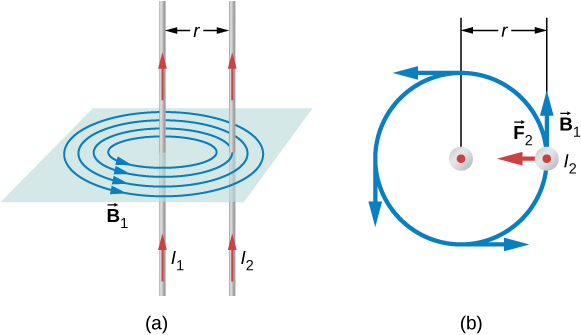
This field is uniform from the wire 1 and perpendicular to it, so the force ![]() it exerts on a length l of wire 2 is given by
it exerts on a length l of wire 2 is given by ![]() with
with ![]()
![]()
The forces on the wires are equal in magnitude, so we just write F for the magnitude of ![]() (Note that
(Note that ![]() ) Since the wires are very long, it is convenient to think in terms of F/l, the force per unit length. Substituting the expression for
) Since the wires are very long, it is convenient to think in terms of F/l, the force per unit length. Substituting the expression for ![]() into (Figure) and rearranging terms gives
into (Figure) and rearranging terms gives
![]()
The ratio F/l is the force per unit length between two parallel currents ![]() and
and ![]() separated by a distance r. The force is attractive if the currents are in the same direction and repulsive if they are in opposite directions.
separated by a distance r. The force is attractive if the currents are in the same direction and repulsive if they are in opposite directions.
This force is responsible for the pinch effect in electric arcs and other plasmas. The force exists whether the currents are in wires or not. It is only apparent if the overall charge density is zero; otherwise, the Coulomb repulsion overwhelms the magnetic attraction. In an electric arc, where charges are moving parallel to one another, an attractive force squeezes currents into a smaller tube. In large circuit breakers, such as those used in neighborhood power distribution systems, the pinch effect can concentrate an arc between plates of a switch trying to break a large current, burn holes, and even ignite the equipment. Another example of the pinch effect is found in the solar plasma, where jets of ionized material, such as solar flares, are shaped by magnetic forces.
The definition of the ampere is based on the force between current-carrying wires. Note that for long, parallel wires separated by 1 meter with each carrying 1 ampere, the force per meter is
![]()
Since ![]() is exactly
is exactly ![]() by definition, and because
by definition, and because ![]() the force per meter is exactly
the force per meter is exactly ![]() This is the basis of the definition of the ampere.
This is the basis of the definition of the ampere.
Infinite-length wires are impractical, so in practice, a current balance is constructed with coils of wire separated by a few centimeters. Force is measured to determine current. This also provides us with a method for measuring the coulomb. We measure the charge that flows for a current of one ampere in one second. That is, ![]() For both the ampere and the coulomb, the method of measuring force between conductors is the most accurate in practice.
For both the ampere and the coulomb, the method of measuring force between conductors is the most accurate in practice.
Calculating Forces on Wires Two wires, both carrying current out of the page, have a current of magnitude 5.0 mA. The first wire is located at (0.0 cm, 3.0 cm) while the other wire is located at (4.0 cm, 0.0 cm) as shown in (Figure). What is the magnetic force per unit length of the first wire on the second and the second wire on the first?
Two current-carrying wires at given locations with currents out of the page.
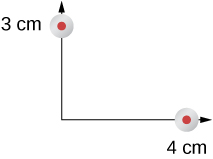
Strategy Each wire produces a magnetic field felt by the other wire. The distance along the hypotenuse of the triangle between the wires is the radial distance used in the calculation to determine the force per unit length. Since both wires have currents flowing in the same direction, the direction of the force is toward each other.
Solution The distance between the wires results from finding the hypotenuse of a triangle:
![]()
The force per unit length can then be calculated using the known currents in the wires:
![]()
The force from the first wire pulls the second wire. The angle between the radius and the x-axis is
![]()
The unit vector for this is calculated by
![]()
Therefore, the force per unit length from wire one on wire 2 is
![]()
The force per unit length from wire 2 on wire 1 is the negative of the previous answer:
![]()
Significance These wires produced magnetic fields of equal magnitude but opposite directions at each other's locations. Whether the fields are identical or not, the forces that the wires exert on each other are always equal in magnitude and opposite in direction (Newton's third law).
Check Your Understanding Two wires, both carrying current out of the page, have a current of magnitude 2.0 mA and 3.0 mA, respectively. The first wire is located at (0.0 cm, 5.0 cm) while the other wire is located at (12.0 cm, 0.0 cm). What is the magnitude of the magnetic force per unit length of the first wire on the second and the second wire on the first?
Both have a force per unit length of ![]()
Summary
Conceptual Questions
Compare and contrast the electric field of an infinite line of charge and the magnetic field of an infinite line of current.
Is ![]() constant in magnitude for points that lie on a magnetic field line?
constant in magnitude for points that lie on a magnetic field line?
A magnetic field line gives the direction of the magnetic field at any point in space. The density of magnetic field lines indicates the strength of the magnetic field.
Problems
Two long, straight wires are parallel and 25 cm apart. (a) If each wire carries a current of 50 A in the same direction, what is the magnetic force per meter exerted on each wire? (b) Does the force pull the wires together or push them apart? (c) What happens if the currents flow in opposite directions?
Two long, straight wires are parallel and 10 cm apart. One carries a current of 2.0 A, the other a current of 5.0 A. (a) If the two currents flow in opposite directions, what is the magnitude and direction of the force per unit length of one wire on the other? (b) What is the magnitude and direction of the force per unit length if the currents flow in the same direction?
a. ![]() away from the other wire; b.
away from the other wire; b. ![]() toward the other wire
toward the other wire
Two long, parallel wires are hung by cords of length 5.0 cm, as shown in the accompanying figure. Each wire has a mass per unit length of 30 g/m, and they carry the same current in opposite directions. What is the current if the cords hang at ![]() with respect to the vertical?
with respect to the vertical?
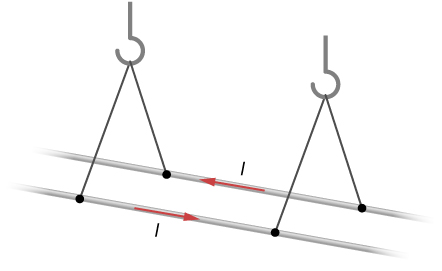
A circuit with current I has two long parallel wire sections that carry current in opposite directions. Find magnetic field at a point P near these wires that is a distance a from one wire and b from the other wire as shown in the figure.
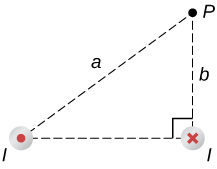
![]()
The infinite, straight wire shown in the accompanying figure carries a current ![]() The rectangular loop, whose long sides are parallel to the wire, carries a current
The rectangular loop, whose long sides are parallel to the wire, carries a current ![]() What are the magnitude and direction of the force on the rectangular loop due to the magnetic field of the wire?
What are the magnitude and direction of the force on the rectangular loop due to the magnetic field of the wire?
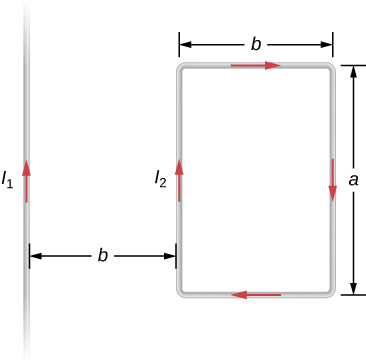
Two Wires With Currents as Indicated Are Shown Below. Where Is the B-field Zero?
Source: https://opentextbc.ca/universityphysicsv2openstax/chapter/magnetic-force-between-two-parallel-currents/
0 Response to "Two Wires With Currents as Indicated Are Shown Below. Where Is the B-field Zero?"
Publicar un comentario